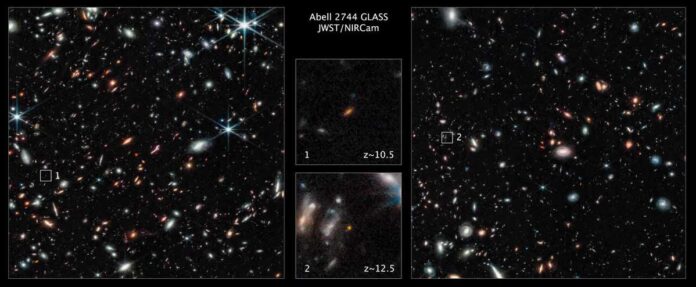The James Webb Space Telescope (JWST) of NASA has discovered an unexpectedly rich realm of early galaxies. It had previously been largely hidden, beyond the reach of other telescopes.
Researchers discovered two extremely bright galaxies that existed between 350 and 450 million years after the big bang. These and other findings are leading astronomers to believe that an unusually large number of galaxies in the early universe were much brighter than expected.
Two papers published in Astrophysical Journal Letters were led by Marco Castellano of the National Institute for Astrophysics in Rome, Italy, and Rohan Naidu of the Harvard-Smithsonian Center for Astrophysics and the Massachusetts Institute of Technology in Cambridge, Massachusetts. Illingworth collaborated on the Naidu et al. paper.
These preliminary findings are part of a larger JWST research initiative that includes two ERS programmes. The Grism Lens-Amplified Survey from Space (GLASS) and the Cosmic Evolution Early Release Science Survey (CEERS).
Researchers discovered the two exceptionally bright galaxies in the GLASS-JWST images after only four days of analysis. These galaxies were formed between 450 and 350 million years after the big bang (with a redshift of approximately 10.5 and 12.5, respectively). Future JWST spectroscopic measurements will be required to confirm their distances.
Another surprise was the early discovery of galaxies with compact discs. It was only possible due to JWST’s much sharper images in infrared light than Hubble.
Illingworth emphasised that the two bright galaxies discovered by these teams are very bright. He speculated that they could have been very massive, with many low-mass stars, similar to later galaxies. They could also be much less massive, made up of far fewer extremely bright stars known as Population III stars. Long thought to be the first stars to form, they would blaze at blistering temperatures and be composed entirely of primordial hydrogen and helium. Before stars could later cook up heavier elements in their nuclear fusion furnaces. There are no such extremely hot, primordial stars in the local universe.
The current Webb distance estimates for these two galaxies are based on infrared colour measurements. Follow-up spectroscopy measurements of how light has been stretched in the expanding universe will eventually provide independent verification of these cosmic yardstick measurements.
The James Webb Space Telescope is an international project led by NASA and its partners, the European Space Agency and the Canadian Space Agency (Canadian Space Agency).

